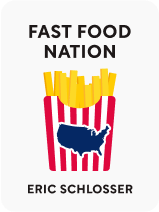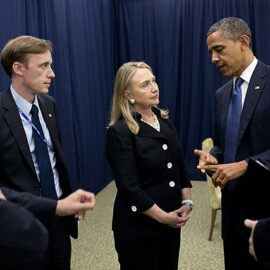

This article is an excerpt from the Shortform book guide to "Fast Food Nation" by Eric Schlosser. Shortform has the world's best summaries and analyses of books you should be reading.
Like this article? Sign up for a free trial here .
Is marketing to kids effective? How do fast food companies market to kids?
Marketing to kids is a long-standing, if controversial, marketing and advertising tactic. Fast food companies, in particular, rely on marketing to kids as a part of their overall strategy.
Read more about marketing to kids and how fast food companies do it.
Marketing to Kids in Fast Food
The McDonald brothers may have started the company and given it its famous name, but their vision for it was relatively limited. They were content being regionally successful restaurant entrepreneurs, making approximately $100,000 per year (by no means a small sum in the mid-1950s). They did not see the global potential of what they had created—that vision was Ray Kroc’s.
Kroc was an unlikely individual to emerge as one of the leading figures in a new and rising industry that was largely driven by youth culture. When he first visited the McDonald’s Self-Service Restaurant in 1954, he was already in his fifties, with a largely unremarkable career as a travelling salesman behind him.
Seeing the potential of the McDonald’s system and how it could be replicated on a national (and eventually global) scale, Kroc seized the opportunity. He bought from the McDonald brothers the right to franchise McDonald’s nationwide. Taken at face value, this deal was appealing to the brothers—they could stay at home and count their money while Kroc travelled across the country promoting the brand and taking most of the risks. But Kroc would determine the ultimate direction and shape of McDonald’s, not the founding brothers.
Kroc saw that expansion was important to building up the brand: to him, it was more important to have new McDonald’s restaurants opening up than it was to have a uniform set of financial details for each new franchise. He kept the franchise fees low for new franchisees and made a conscious effort to help them be successful. This patient and nurturing strategy paid off and resulted in the successful expansion of McDonald’s. In 1961, Kroc had done well enough in growing the company to secure the financing to buy the brothers out. As a symbol of his total triumph over them, Kroc opened up a McDonald’s across the street from a new restaurant they opened (called “The Big M”) and ran it out of business.
Kids: The Best Salespeople
Kroc instituted a philosophy, the core values that would guide McDonald’s—Quality, Service, Cleanliness, and Value. He was a dogged believer in McDonald’s, selling franchises with an almost holy zeal. What he understood keenly was the power that young people had over American consumer spending—especially children. Like his contemporary and friend Walt Disney (with whom he has often been compared), Kroc was a master at marketing to kids. Once again, the strategy was right for the times. America was experiencing the baby boom of the postwar years, during which birth rates skyrocketed—between 1944 and 1961, over 65 million children were born in the United States. There was now a youth market that, in terms of sheer scale and disposable income, was unlike anything that had ever existed before.
To bring in families with young children, Kroc knew he needed to create a wholesome, clean, All-American image for McDonald’s and work on marketing to kids. Even in these early days, there was an emphasis on bright, colorful mascots and an entertaining atmosphere for children. In 1965, McDonald’s unveiled a new mascot who would come to eclipse even Disney’s Mickey Mouse in popularity: Ronald McDonald. Expanding on this idea, Kroc installed mini playgrounds at each McDonald’s location. This, of course, attracted more children, which attracted more parents and grandparents—and more sales.
Under Kroc’s direction, McDonald’s became a pioneer at marketing to children, a practice that is now widespread across consumer brands. By the early 2000s, there existed an entire subset of the marketing and advertising industries devoted solely to fostering brand loyalty in children. Indeed, this familiarity and affinity with brands and products can begin in children as young as two.
Marketers recognize that kids are powerful surrogate salespeople and brand ambassadors. By bugging and cajoling their parents, children exert a great deal of influence over family spending decisions. Within the marketing industry, this has been distilled down to a science, with advertisers differentiating between the different types of whining and pleading that kids will do to harangue their parents. Marketers have, for example, identified pleading nags (repetition of “please”) and sugar-coated nags (in which kids promise affection in exchange for the product they want) as highly distinct appeals. The goal is always to get kids to feel a natural affection, even love for the brand, a bond as close as that they feel for their own family.
For marketing to kids, advertisers need to study kids. Today, they survey children at malls and public places, run focus groups on them, and even study their artwork to unlock the elusive (but lucrative) mystery of what exactly it is they want. They have even enlisted child psychologists into their efforts, using a technique called the Character Appeal Quadrant Analysis to help craft characters and mascots that ideally suit their target audience’s level of psychological and emotional development. This is especially effective, as research has consistently shown that children are seldom able to tell the difference between TV shows and TV advertising.
Efforts to crack down on advertising targeted at children have met with fierce opposition from special-interest groups. As far back as 1978, the Federal Trade Commission attempted an outright ban on all television ads aimed at kids under seven—but lobbies like the National Association of Broadcasters, the Toy Manufacturers of America, and the Association of National Advertisers used their influence in Congress to stymie the effort.

———End of Preview———
Like what you just read? Read the rest of the world's best book summary and analysis of Eric Schlosser's "Fast Food Nation" at Shortform .
Here's what you'll find in our full Fast Food Nation summary :
- How the fast food industry reshaped the American economy
- How fast food marketing is manipulating you
- Why the rise of fast food has destroyed family farms across America






